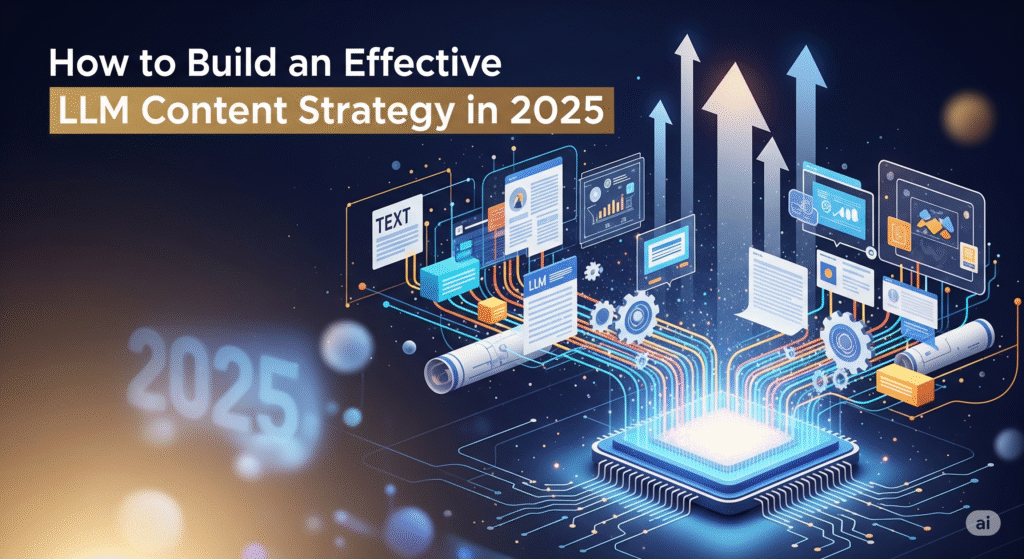By 2025, Google will no longer be the first and last stop for content discovery. Your content now exists in AI-driven conversations where users compare brands, ask questions, and make decisions without ever clicking a link thanks to the emergence of Large Language Models (LLMs) like ChatGPT, Gemini, and Claude.
This change is redefining visibility, not just how people search. If your brand isn’t appearing in AI responses, you’re losing clicks, authority, trust, and top-of-mind awareness.
In the era of LLMs, how do you position your content to be trusted, found, and cited?
This guide demonstrates a tried-and-true, step-by-step LLM content strategy that enhances semantic relevance, adapts to contemporary buyer behavior, and transforms your brand from a result to a source.
Here’s a detailed guide to creating a high-impact LLM content strategy that improves visibility, conforms to contemporary search behavior, and positions your brand as a reliable source for generative AI platforms as well as search engines.
Step 1: Run an AI Visibility Audit
Start by assessing how visible your brand is inside AI platforms like ChatGPT.
- Where is your brand mentioned?
- Which prompts surface your content?
- Are competitors being cited where you’re absent?
This audit reveals crucial gaps and opportunities. Knowing how LLMs perceive your brand today gives you a roadmap to improve tomorrow.
Step 2: Extract Buyer-Led Prompts
Don’t assume what your audience is asking. Discover it.
Use tools like:
- Google’s People Also Ask
- Reddit discussions
- Sales call transcripts
These help you identify bottom-of-funnel prompts and reverse-engineer the user’s decision journey. The closer you align with real user queries, the more likely you are to be cited by LLMs.
Step 3: Identify Your “FUQs”
“Frequently Unasked Questions” are the gaps in the market—questions people need answers to but haven’t voiced yet.
Why do they matter?
Because when you publish original answers backed by research, you don’t just answer questions—you become the source. That’s what earns citations in AI outputs.
Step 4: Build a Semantic Anchor Page
LLMs rely on structured data to “understand” entities. So you need a well-structured page that acts as your brand’s semantic anchor.
- Create a detailed Entity Home Page
- Add Schema.org structured data and
sameAslinks to social profiles - Include founding story, product details, customer info, and what makes you different
This helps AI models know who you are and why you matter.
Step 5: Correct Your Messaging Everywhere
Inconsistent brand messaging confuses AI models.
Align messaging across:
- Bios
- Press pages
- Affiliate content
- Third-party sites
When your brand descriptions match across the web, LLMs gain a clearer, more authoritative understanding of your identity.
Step 6: Optimize for AI-Parseable Content
Your content should be easy for both humans and machines to digest.
- Use short sentences and clear, ordered sections
- Structure thoughts as semantic triples (subject → object → predicate)
- Rely on natural headers and conversational tone
Ask yourself: Is this easy to quote? If yes, you’re doing it right.
Step 7: Pitch Cited Sources
Want to get cited by ChatGPT? Start by identifying what it already cites.
- Study the blogs, publishers, and articles that show up in AI responses
- Collaborate, contribute, or get featured on those platforms
In the LLM era, citations = credibility. Build them like you used to build backlinks.
Step 8: Track the Right Metrics
Since there’s no native analytics dashboard for ChatGPT, you’ll need to build your own.
Track:
- Your share of LLM citations by prompt
- Funnel stage distribution (TOFU, MOFU, BOFU)
- Engagement from AI-driven users
Measure the unseen to grow where others aren’t looking.
Step 9: Treat It Like a Growth Loop
LLM content strategy isn’t static. It’s iterative.
- Audit your visibility
- Act on findings
- Re-measure performance
- Repeat the cycle
This feedback loop drives ongoing growth inside AI platforms and builds long-term brand authority.
Final Thoughts
The future of content isn’t just about ranking in search engines—it’s about showing up in conversations, answers, and intelligent agents. By following this LLM-centric content strategy, you position your brand at the intersection of visibility, trust, and AI-led discovery.
As traditional SEO reaches its saturation point, the brands that will win the next decade are the ones that optimize not just for search engines, but for language models.
The LLM content strategy you just explored is more than a marketing playbook — it’s a framework for AI-native growth. From auditing visibility to building citations and aligning messaging, each step helps you meet users where they already are: inside AI platforms, asking real questions.
The opportunity isn’t in ranking higher — it’s in becoming the answer.
So start now. Build your semantic foundation, close visibility gaps, and track what really matters. Because the future of content isn’t just published — it’s parsed, quoted, and remembered by machines.
And the brands that adapt? They won’t just be found.
They’ll be trusted.

